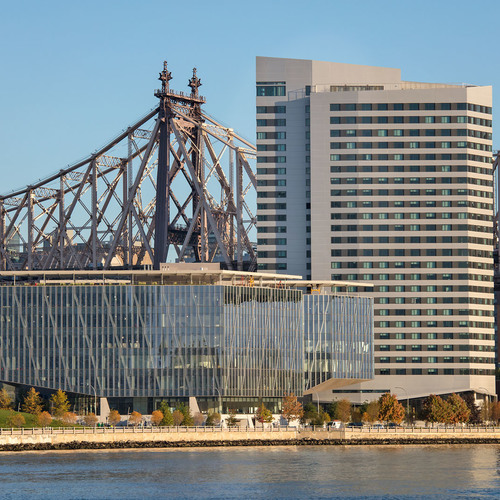Image Credit: Hudson Companies
Image Credit: Hudson Companies The new Passivhaus residential tower, located at the right rear of this drawing, will be part of a $2 billion campus constructed over the next two decades. The tower is being developed by the Hudson Companies Inc. along with Cornell Tech, the applied sciences campus of Cornell University, according to The New York Times.
Image Credit: Hudson Companies
Work has started on a 26-story apartment building in New York that when completed in 2017 will be the world’s tallest and largest Passivhaus structure.
The 270,000-square-foot tower on Roosevelt Island, which lies between the New York City boroughs of Manhattan and Queens, will house 530 graduate students, faculty, and staff on a new 12-acre Cornell Tech campus, according to an article in The New York Times.
“Sustainability in terms of campus design is just hugely important to Cornell,” Jennifer Klein, an assistant director for strategic capital partnerships at Cornell Tech, told the newspaper. “The idea for our residential tower was we take that mission even further, and we really do set the bar for this energy-efficient type of development throughout New York City.”
Currently, the world’s tallest Passivhaus building is a 20-story office tower in Vienna.
Panelized wall system
The building’s $115 million budget precluded the use of a double-walled glass design common in European Passivhaus buildings, the newspaper said. Instead, the building will be constructed from prefabricated metal wall sections.
Arianna Sacks Rosenberg, senior project manager with the developer, the Hudson Companies Inc., said by email the wall sections are 14 inches thick at their deepest and insulated with 11 inches of mineral wool. Some areas of the wall are thinner. R-values range from 18 to 30, Rosenberg said, with an average R-value for the assembly 20.
The triple-glazed windows, made by Schuco, have a U-factor of 0.156 (calculated by the European method). Windows will be shipped directly to Eastern Exterior Wall Systems, which is manufacturing the wall components, so they can be incorporated during assembly.
Blake Middleton, a partner at Handel Architects and the principal in charge of the project, told The Times that in addition to saving money, this approach would speed up construction and reduce the number of joints that would have to be sealed.
Details of the roof assembly, including insulation and R-value, have yet to be worked out.
Heating and cooling with heat pumps
Variable refrigerant flow air-source heat pumps will provide heating and cooling, Rosenberg said, adding that the units are ideal because they are designed to perform efficiently at a partial load.
A centralized energy-recovery ventilator (ERV) located on the roof of the building will provide fresh air to, and exhaust stale air from, each apartment. Specs for the ERV haven’t been completed.
Although the campus will have some photovoltaic (PV) panels for the first academic building, the residential tower will not have any renewable energy systems. However, each of the apartments — ranging from 350-square-foot “micro units” to one-, two-, and three-bedroom apartments — will be submetered. Rosenberg said plans call for an interactive energy management system so that residents can keep tabs on energy consumption, and, according to The Times, residents will pay their own power bills.
The new tower is part of a $2 billion project that will be built over the next 20 years. The first academic building on the campus, also part of the first phase of the project, will be one of the largest net-zero energy buildings in the country, The Times reported.
The developers will seek certification through the Passivhaus Institut in Germany. When the project was first designed, there was only one Passivhaus standard. Since then, the Passivhaus Institut has rewritten its specs to include three levels of certification, but developers will be seeking a “classic” level of certification rather than either the “Plus” or “Premium” levels now on the books.
Weekly Newsletter
Get building science and energy efficiency advice, plus special offers, in your inbox.













One Comment
Progress is a good thing
Nice to see a high-rise building utilizing triple pane windows and going to a PassivHaus standard. If not for the standard & certification then they would just build another energy hog high-rise.
Log in or create an account to post a comment.
Sign up Log in